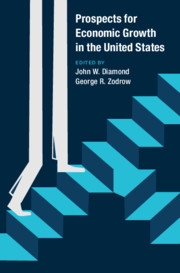Book contents
- Prospects for Economic Growth in the United States
- Prospects for Economic Growth in the United States
- Copyright page
- Dedication
- Contents
- Figures
- Tables
- Notes on Contributors
- Foreword
- Preface
- Acknowledgments
- Part I Overview
- Part II Labor and Economic Growth
- Part III Implications of Technology for Growth
- Part IV The Effects of Fiscal Policy on Growth
- Part V Special Topics on Economic Growth
- Part VI A Concluding Perspective
- Index
- References
Part III - Implications of Technology for Growth
Published online by Cambridge University Press: 21 October 2021
- Prospects for Economic Growth in the United States
- Prospects for Economic Growth in the United States
- Copyright page
- Dedication
- Contents
- Figures
- Tables
- Notes on Contributors
- Foreword
- Preface
- Acknowledgments
- Part I Overview
- Part II Labor and Economic Growth
- Part III Implications of Technology for Growth
- Part IV The Effects of Fiscal Policy on Growth
- Part V Special Topics on Economic Growth
- Part VI A Concluding Perspective
- Index
- References
Summary

- Type
- Chapter
- Information
- Prospects for Economic Growth in the United States , pp. 113 - 170Publisher: Cambridge University PressPrint publication year: 2021

